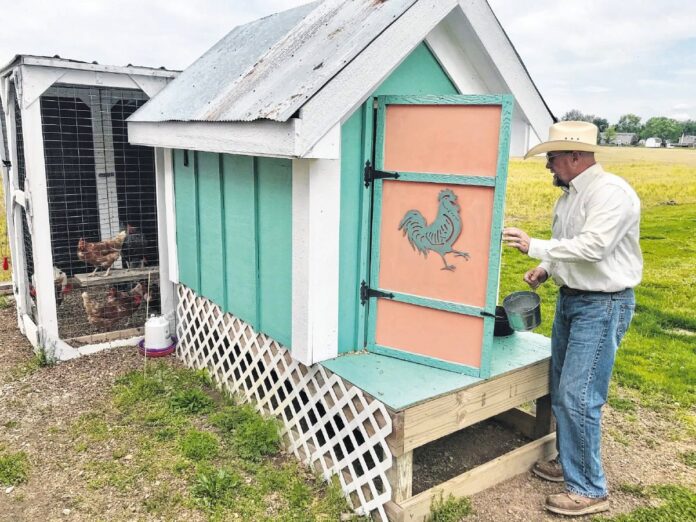
NEW PALESTINE — The 30 chickens in the coop at Jim Robinson’s home have plenty of space to roam, particularly when they’re let loose onto the two acres of family land. Robinson, the New Palestine town manager, lives about a half mile outside the town’s limits and can have as many farm animals as the family would like.
Robinson often hears town residents expressing a desire to keep chickens in coops inside the town limits, and officials have obliged with certain regulations. The town council on Wednesday, May 19, unanimously approved an ordinance establishing standards for maintaining chicken flocks in town.
“There is nothing better than fresh eggs; plus, chickens are a fun pet,” Robinson said.
While people inside town limits have been able to keep fowl on their property as long as they are in a pen or secured enclosure, officials wanted to be more specific on rules surrounding chicken coops and runs. The new ordinance is something council president Bill Niemier was glad to see the council address.
“It’s not as uncommon for people to want to have chickens on their property as it might have been previously,” Niemier said during a council meeting earlier this month, prompting the issue to get addressed.
The ordinance puts in place several requirements: No roosters can be kept within the town limits; the coops cannot be a public nuisance or disturb neighboring residents due to noise, odor or damage; coops cannot pose a threat to public health; and they must comply with all provisions of applicable local, state and federal laws regarding general animal care. Chickens also must be kept in enclosures and must be under the person’s control at all times.
The new ordinance also states people who want to keep chickens must provide both a chicken coop and attached chicken run that afford a combined 12 square feet per chicken. The structure also must be kept clean, dry and odor-free.
Owners must provide a fence or shrub screening of at least four feet in height around both coop and run if it can be seen by neighbors, and the facility must be at least 15 feet from the property line of any neighboring lot.
Before the vote, Niemier was adamant about making sure the distance from a coop to a neighbor’s property line was a suitable distance. He advocated for a 20-foot buffer, but in the end council members settled on 15 feet after council member Brandee Bastin suggested 20 feet may be too much, particularly for homeowners with smaller yards. Council member Clint Bledsoe thought the ordinance was strict and said he didn’t think anyone would be able to adhere to all the requirements, such as the noise section and the requirement of adding a barrier around the coop, but he was actually good with that.
“I can’t have chickens at my house,” Bledsoe said. “I keep all my chickens at the store.”
While the ordinance doesn’t limit the number of chickens a homeowner can have, Robinson said they quickly can multiple and noted his family started out with six chickens and quickly blossomed to five times as many. That’s something people who want to house chickens inside the town’s limits will have to think about if they maintain the birds.
“It takes a lot of dedication to have chickens,” Robinson said. “They need to be watered and fed; and another thing, they can live five to 10 years, but only lay eggs up to three years, so people need to think about what they will do with their chickens after they don’t lay eggs.”




